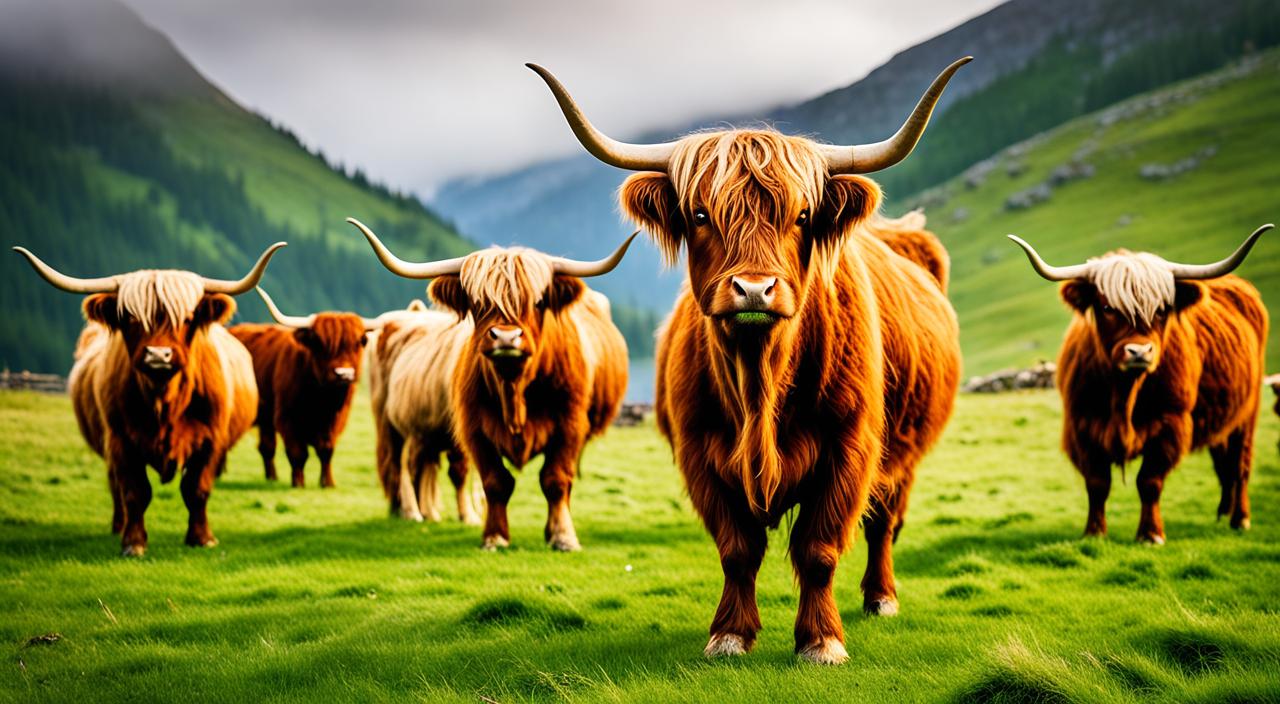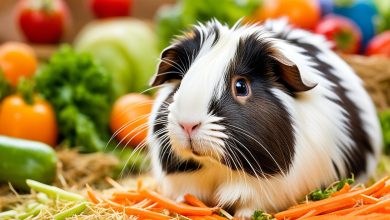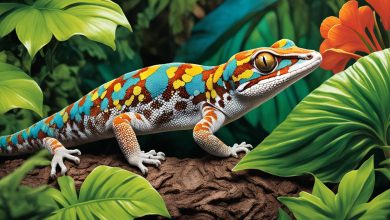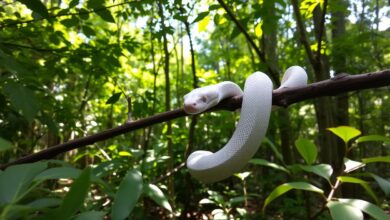Highland cattle can grow up to 800 kg and are a key part of Scotland’s rural scene for centuries. They are known for their shaggy coats and horns. Their gentle nature has won the hearts of people worldwide, making them a top attraction in the Scottish Highlands. These cattle are tough and have thrived in the harsh Scottish environment. They play a big role in the area’s farming and culture.
These cattle come from the 6th century in the Outer Hebrides. They are valued for their ability to adapt, friendly nature, and top-quality beef. Through careful breeding over the years, their unique traits have been kept alive. Their shaggy coats and big horns still amaze and inspire locals and visitors from all over.
The Majestic Highland Cattle Breed
Origins and History
The Highland cattle breed is the oldest registered cattle breed worldwide. They have been in the Outer Hebrides of Scotland since the 6th century. These magnificent animals have adapted to the tough Scottish Highlands over time.
They split into two groups: the West Highlands or Kyloe, and the Highlander. Each group suited their unique environments. The Highland Cattle Herd Book started in 1885, keeping track of every pedigree.
Highland cows live long, often over 18 years. Their adaptability has made them popular around the globe. They are now found in the USA, Canada, Australia, New Zealand, and many European countries.
Distinctive Physical Characteristics
Highland cattle stand out with their long, curved horns and thick, wavy coat. They come in many colors like red, ginger, black, and more. Bulls can weigh up to 800 kg, and cows up to 500 kg.
Their long hair and double coat keep them warm in the cold Scottish weather. Their strong legs help them move over rough ground.
Highland Cattle beef is highly valued for its quality. It comes from 100% pure Highland Cattle. These cattle are raised in Britain’s hills and uplands. They produce lean, well-marbled beef with less fat and cholesterol than other types.
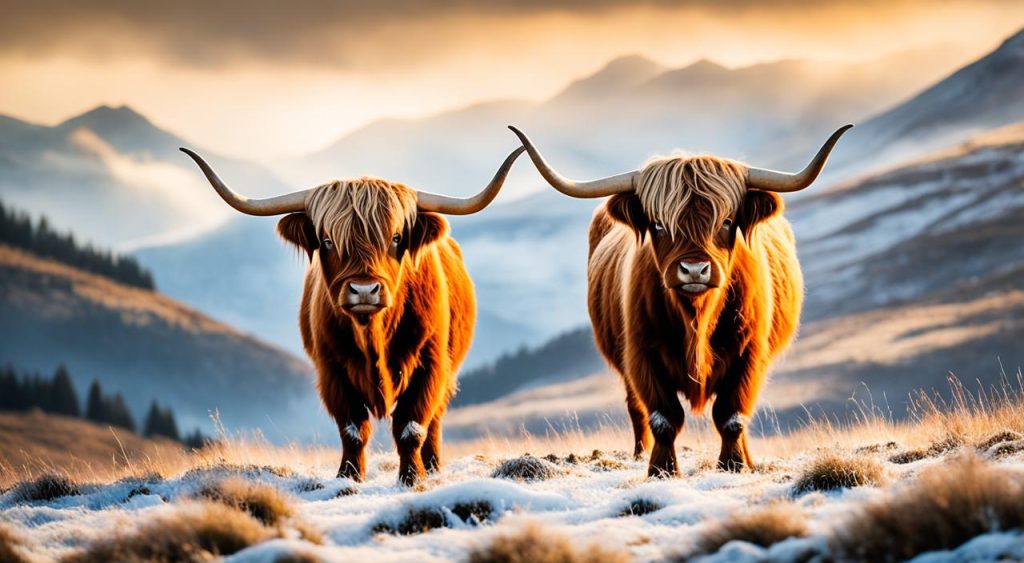
Hardy and Resilient Nature
The Highland cattle are famous for their hardy and resilient nature. This has helped them live well in the tough Scottish Highlands. They have thick, shaggy coats and strong bodies. They can eat a wide variety of plants, which helps them survive the cold, wet weather.
These tough animals can handle the harsh winters and climb steep, rocky hills. They are perfect for their home in the Highlands. Their ability to bounce back shows how they evolved in the tough Scottish landscapes.
Survival in the Scottish Highlands
Highland cattle eat different grasses and plants, showing how well they adapt to tough places. They eat the tasty parts of plants in summer and eat rougher stuff like heather and tree bark in winter.
- Highland cattle can eat too much, which can harm the environment. Farmers must manage how much land they use carefully.
- These cattle sometimes break through fences to explore or find new food. This can cause problems with neighbors and damage crops.
Despite these issues, Highland cattle do well in the Scottish Highlands. They show how hardy and resilient they are. They are a big part of Scottish culture, appearing in stories, books, and festivals.
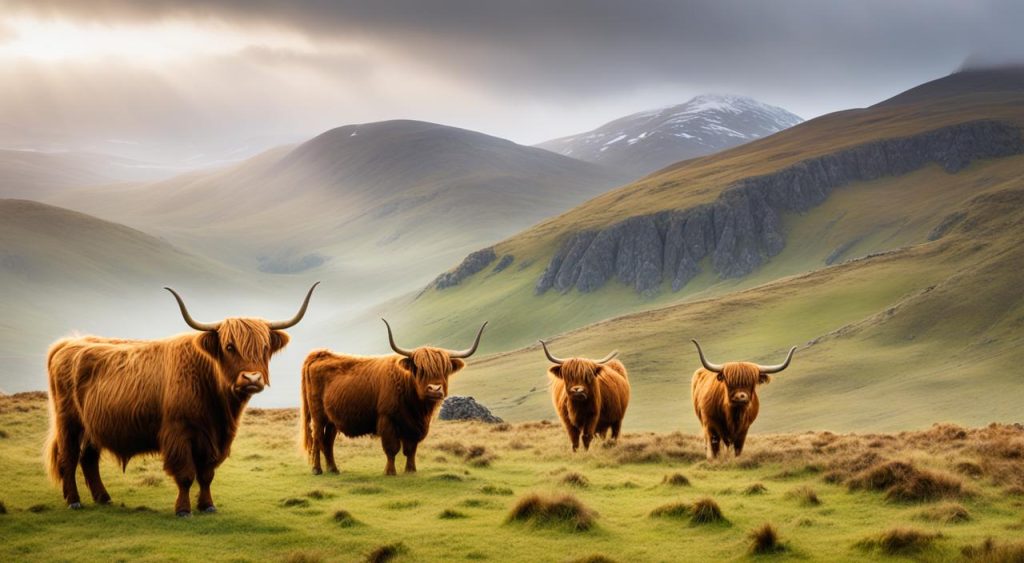
Highland Cattle Temperament
Highland cattle are known for their gentle and friendly nature. They are often called “gentle giants” because of their calm and friendly ways. These traits make them a pleasure to be around for farmers and visitors.
They are smart and curious, which leads them to trust and work well with humans. This makes them even more special to those who meet them.
Gentle Giants: Friendly Disposition
Highland cattle are known as the gentle giants of the cattle world. They are smart, curious, and eager to interact with people. This makes them a joy to work with and a hit with visitors to rural areas.
“Highland cattle are often celebrated for their calm, docile nature and approachable demeanor, making them a joy to interact with, both for farmers and visitors.”
They stand out for their friendly and calm nature compared to other cattle breeds. Their ability to work well with people makes them perfect for farms and tourism.
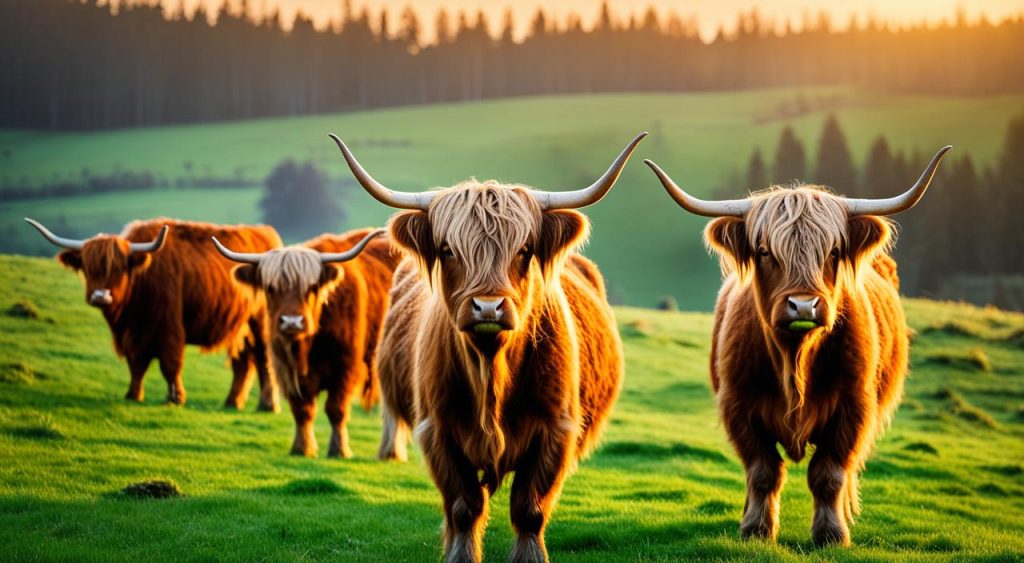
The Highland cattle’s gentle nature and friendly ways have made them very popular. They form strong bonds with their human caretakers. This makes them valuable both as working animals and as attractions in the countryside.
Social Structure and Behavior
Highland cattle, the majestic bovines of the Scottish Highlands, have a unique social structure. They live in groups called a “fold.” A dominant, experienced female cow leads the group, guiding them and keeping peace.
These cattle are very cooperative, showing behaviors that strengthen their social bonds. For example, they groom each other. Calves learn important social and survival skills from older cows in the fold. This community focus is key to their success and survival in their native land.
Studies reveal that Highland cattle form close social bonds over time. These bonds reduce stress and help maintain a stable social order in the fold. The size and density of the group affect its dynamics, with bigger groups showing more complex social structures and leadership.
“Highland cattle possess a unique and fascinating social structure, with the older, dominant cows guiding the herd and ensuring the overall well-being of the fold.”
Research into Highland cattle herds has uncovered much about their cooperation, hierarchy, and adaptation. Their community behavior is crucial to their resilience and success in the Scottish Highlands.
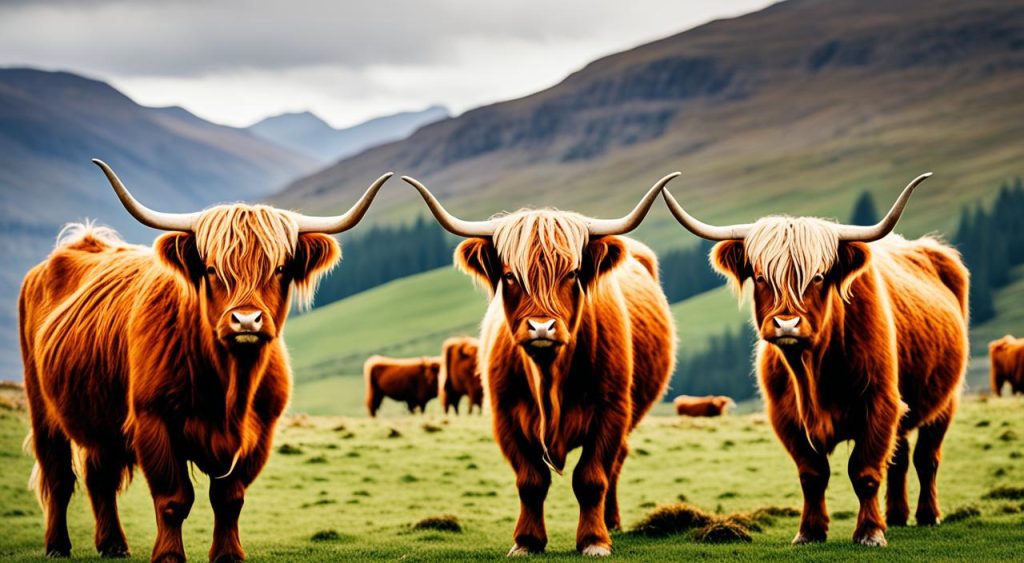
In summary, Highland cattle’s social structure and behavior are closely linked, aiding their success. From the leadership of experienced cows to the cooperative fold, these gentle giants show remarkable social smarts. This has helped them to thrive in their native habitat.
Grazing and Feeding Habits
Highland cattle are known for their great foraging skills. They live well on a wide variety of plants in the Scottish Highlands. Their grazing habits and feeding habits let them get nutrients from tough grasses and shrubs that others can’t.
Adaptable Foragers
Highland cattle graze carefully and slowly. This way, they use the vegetation in their area well. They can move over tough terrain and eat many types of plants. This helps them survive in the tough Scottish weather.
Studies show Highland cattle do well on different foods. They eat grass, hay, and even peas, turnips, or brewery hop residue. This makes them good for sustainable farming, even where land is limited.
Watching how Highland cattle graze helps farmers manage their herds better. Things like the quality of the land, weather, and pests affect their eating habits. They usually graze most at sunrise and dusk.
“Highland cattle’s methodical and unhurried grazing behavior allows them to extract maximum nutrients from the tougher vegetation found in the Scottish Highlands.”
By learning about the adaptable foraging of Highland cattle, farmers can keep the ecosystem balanced. They can use the land well and reduce their environmental impact. This helps make farming sustainable.
Maternal Instincts and Reproduction
Highland cattle are famous for their strong maternal instincts and breeding skills. These gentle giants thrive in tough environments, showing their resilience. They are highly fertile and can breed well, even in harsh conditions.
After giving birth, Highland mothers take great care of their calves. They teach them important survival skills and social behaviors. This strong bond between a mother and calf is clear. Cows also look after each other’s calves, showing the tight-knit nature of Highland cattle.
Highland cows have a lot of calves over their long lives, about 12 on average. This means fewer calves need to be replaced, saving farmers money. Their milk is rich and full of fat, helping their calves grow strong and healthy.
Highland cattle are often crossed with other breeds. This makes their calves stronger, healthier, and better at fighting off diseases. These crossbred animals are great for beef production and do well in herds.
The success of Highland cattle in breeding and caring for their young shows their amazing adaptability. Their strong bond with the land and each other is truly inspiring. These gentle giants of the Scottish Highlands continue to amaze and move those who meet them.
Highland Cattle and Sustainable Farming
Environmentally Friendly Livestock
Highland cattle are key to sustainable farming and protecting the environment. They can live in tough places like the Scottish Highlands and the Andes Mountains. They eat a variety of plants, making them great for farmers who care about the planet.
These cows help keep ecosystems balanced by eating certain plants and not others. This stops some plants from taking over, which helps many plant species to grow. They also need less food than other cows, which is good for the environment.
Black Hill Highlands, a place focused on sustainable farming, has 50 acres of land. They offer tours all year to teach people about sustainable ranching. The ranch is between Deadwood and Spearfish and teaches about nature and habitat management. Kids love seeing the highland cows there.
The ranch aims to show how sustainable farming helps the environment. Grass-fed beef from Highland cattle is healthier than regular beef. It has more omega-3 and omega-6 fatty acids, Vitamin E, and CLA.
Highland cows are easy to care for and can live on tough land. They help control weeds and support many types of plants on farms. They are also gentle, making them safe for beginners and kids.
“Highland cows are not only majestic creatures, but they also play a vital role in promoting sustainable and environmentally friendly farming practices. Their adaptability and low-maintenance requirements make them an ideal choice for conservation-minded farmers and ranchers.”
Beef Production and Meat Quality
Highland cattle are known for their top-notch beef production and meat quality. Their meat is lean, flavorful, and low in fat and cholesterol. It’s also packed with protein, making it a great choice for those watching their health.
Research shows that Highland beef is 38% lower in fat and 4% lower in cholesterol than regular supermarket beef. It has only 4.5g of fat per 100g, compared to 15.6g in other breeds. The cholesterol level is also lower, at 40.9mg per 100g, versus 64.3mg in other beef types.
Highland beef is more than just low in fat and cholesterol. It’s rich in essential vitamins and minerals, like vitamin B12, zinc, selenium, niacin, vitamin B6, and phosphorus. It’s also full of heart-healthy omega-3 fatty acids and conjugated linoleic acid (CLA), which can fight diseases like diabetes and cancer.
| Nutritional Comparison | Highland Beef | Other Beef Breeds |
|---|---|---|
| Fat (g per 100g) | 4.5 | 15.6 |
| Cholesterol (mg per 100g) | 40.9 | 64.3 |
| Protein (g per 100g) | 20.7 | 18.6 |
| Iron (mg per 100g) | 2.1 | 2.0 |
The quality of Highland beef comes from its unique traits and natural way of life. Eating grass and forage improves the meat’s digestion, flavor, and fat content. Plus, slow growth and maturation of Highland cattle make the meat tender and flavorful.
Highland beef is in high demand for its excellent quality and eco-friendliness. It’s a favorite among food lovers and even the Royal Family at Balmoral Castle.
Tourism and Highland Cattle
Highland cattle are now famous in Scotland’s rural areas, pulling in tourists from all over. Their unique look, with their shaggy coats and big horns, makes them a hit. People love to see these gentle animals up close, feeling a real connection to Scottish heritage.
Iconic Attractions in Rural Landscapes
Farms and conservation spots let visitors get close to these big animals. It’s a chance to see them in their natural setting. You can watch them eat, look at their unique features, and even touch or feed them. It’s an experience you won’t forget.
Highland cattle are a big draw for tourists, bringing people from everywhere to see their charm. Farms and places with tours and hands-on experiences are getting popular. They help keep the Highland breed alive and appreciated.
Because of their popularity, there are now festivals and events for Highland cattle. At these events, like Highland Gatherings and agricultural shows, you can learn about their history and care. It deepens the bond between these animals and Scotland.
“Seeing the Highland cattle grazing in the lush, rolling hills of the Scottish Highlands was a truly magical experience. Their majestic presence and approachable demeanor made it a highlight of our trip.”
Tourism is key to Scotland’s rural economy, and Highland cattle are a big part of it. By showing off these gentle giants, farms and conservation areas draw in visitors. They also help keep the breed going for future generations.
Conservation Efforts
Highland cattle are very important, both for their cultural value and their role in the environment. Groups like the Highland Cattle Society work hard to keep the breed safe. They focus on maintaining breed standards, promoting sustainable farming, and keeping the genetic diversity of these cattle.
These efforts are key to protecting Highland cattle for the future. They make sure we can still enjoy and appreciate this breed for many years. With Highland cattle becoming more popular in the US and Scandinavian countries, it’s more important than ever to keep their unique traits safe.
By promoting the breed, preserving genetic diversity, and supporting sustainable farming, we can keep Highland cattle a key part of farming. They help with biodiversity, soil health, and the environment. These actions are vital for the heritage and the health of the land where they live.
FAQ
What are the distinctive features of Highland cattle?
Highland cattle stand out with their long, shaggy coats and majestic curved horns. They come in many colors like red, ginger, black, and white. These cattle are big, with bulls reaching up to 800 kg and cows up to 500 kg.
How do Highland cattle survive in the rugged Scottish Highlands?
Highland cattle are tough and well-suited to the Scottish Highlands’ tough conditions. Their thick coats and strong bodies help them survive in the cold, wet climate. They can live on a variety of plants, making them perfect for the challenging terrain.
What is the temperament of Highland cattle?
Highland cattle are big but gentle and friendly. They are known for being calm and easy to be around. This makes them a pleasure for farmers and visitors alike.
How do Highland cattle interact within their herds?
Highland cattle live in groups called “folds” with a strong social structure. A wise, experienced cow leads the group. They are very social, often grooming each other to strengthen their bonds.
What are the grazing and feeding habits of Highland cattle?
Highland cattle are great foragers, eating a variety of plants. They eat slowly and carefully, getting the most out of tough plants. This helps keep the environment healthy by maintaining a balanced ecosystem.
How do Highland cattle contribute to sustainable farming and conservation efforts?
Highland cattle are great for the environment because they eat a variety of plants and need fewer resources. Their grazing helps keep the ecosystem balanced. They are a smart choice for farmers who care about the planet.
What are the benefits of Highland cattle beef?
Highland cattle produce beef that is lean, low in fat, and high in flavor and protein. This makes their meat highly valued. It’s also healthier than many other types of beef, which is why it’s so popular.
How do Highland cattle contribute to tourism in Scotland?
Highland cattle are a big draw for tourists in Scotland. People come to see these beautiful animals up close. Their friendly nature makes them a favorite among visitors looking for a real Scottish experience.
What efforts are being made to conserve Highland cattle?
Many groups are working to protect Highland cattle because they are important to Scotland’s culture and environment. The Highland Cattle Society helps maintain the breed’s quality, supports sustainable farming, and keeps the genetic diversity of these cattle alive.
